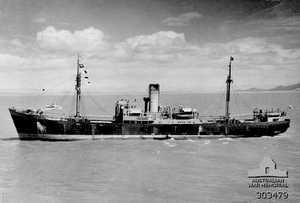SS Karsik (1938)
 SS Karsik during May 1941 | |
| Career | |
|---|---|
| Name: |
SS Soneck SS Karsik[1] SS Pearl of Victory |
| Owner: | Koninklijke Paketvaart-Maatschappij (1940-1963) |
| Builder: | Deutsche Schiff- und Maschinenbau AG, Werk Seebeck, Wesermünde |
| Yard number: | 597 |
| Launched: | 1938 |
| Identification: | IMO: 541291 |
| Fate: | Wrecked in 1967 |
| General characteristics | |
| Type: | Cargo ship |
| Tonnage: | 2,191 GRT[1] |
| Length: | 305 ft 2 in (93.0 m)[1] |
| Beam: | 44 ft 8 in (13.6 m)[1] |
| Draft: | 16 ft 7 in (5.1 m)[1] |
| Installed power: | 367 Nominal horsepower (nhp)[1] |
| Propulsion: | Triple expansion engine |
SS Karsik was a freighter built for DDG Hansa by Deutsche Schiff- und Maschinenbau AG, Werk Seebeck, Wesermünde as Soneck, in 1938, of 2,191 GRT.[1]
World War II impoundment and service
The ship was impounded 10 May 1940 by crew of HNLMS Java for the Netherlands government and operated by Koninklijke Paketvaart-Maatschappij (KPM) in the Dutch East Indies as a train ferry.[2][3] Karsik was one of twenty-one KPM vessels that took refuge in Australian ports after the fall of Java that Dutch officials requested be put into service for the war effort.[4] The ship, among others, was chartered by the Chief Quartermaster, U.S. Army Forces in Australia (USAFIA) on 26 March 1942 with long term details to be negotiated at higher levels to become part of the U.S. Army's local fleet crewed by its KPM officers and men with the number X-20.[5] [note 1]
Karsik, escorted by HMAS Lithgow on the night of 11—12 December 1942, was the first large vessel to arrive at Oro Bay delivering four Stuart light tanks that were loaded into recently arrived barges and then towed up the coast and landed within miles of the battlefront at Buna.[6][7][8] Mayo notes the fact a large ship had arrived and thus the supply line had opened as having perhaps even greater significance than the arrival of the tanks.[8] Karsik then returned on the 14th with a second load of tanks for the forces at Buna. Karsik 's first trip with tanks to Oro Bay was named "Operation Karsik" and the second as "Operation Tramsik" and immediately preceded the regular convoys of Operation Lilliput.[3][6][7]
Post war
She was sold in 1963 to the Leecho Steam Ship Co. of Panama and renamed Pearl of Victory; under which name she struck a reef in the Red Sea and was wrecked on 17 June 1967.
Footnotes
- ↑ Masterson notes the precise charter agreements for KPM ships were somewhat vague but that the agreements were worked with the War Shipping Administration (WSA) and the owning governments. Some similar ships were chartered by the British Ministry of Transport and allocated through WSA to the Army. That would fit with the DDG Hansa reference's "Am 01.03.1942 verchartert an British Ministry of War Transport, London."
References
- Notes
- ↑ 1.0 1.1 1.2 1.3 1.4 1.5 1.6 Lloyd's Register 1941-42.
- ↑ DDG Hansa: D/S SONECK.
- ↑ 3.0 3.1 Australian War Memorial: Karsik and Tramsik.
- ↑ Masterson 1949, pp. 321—322.
- ↑ Masterson 1949, pp. 321—322, Appendix 30, p. 3.
- ↑ 6.0 6.1 Masterson 1949, pp. 588—589.
- ↑ 7.0 7.1 Gill 1968, pp. 244, 245.
- ↑ 8.0 8.1 Mayo 1968, p. 82.
- Bibliography
- Australian War Memorial. "Karsik and Tramsik: Operation Lilliput". Allies in Adversity: Australia and the Dutch in the Pacific War. Australian War Memorial. Retrieved 21 December 2014.
- Deutsche Dampfschifffahrts-Gesellschaft "HANSA" Bremen. "D/S SONECK". Deutsche Dampfschifffahrts-Gesellschaft "HANSA" Bremen. Retrieved 21 December 2014.
- Gill, G. Hermon (1968). Royal Australian Navy 1939–1942. Australia in the War of 1939–1945. Series 2 – Navy 2. Canberra: Australian War Memorial. Retrieved 15 July 2013.
- Masterson, Dr. James R. (1949). U. S. Army Transportation In The Southwest Pacific Area 1941-1947. Washington, D. C.: Transportation Unit, Historical Division, Special Staff, U. S. Army.
- Mayo, Lida (1968). The Technical Services—The Ordnance Department: On Beachhead And Battlefront. United States Army In World War II. Washington, DC: Center Of Military History, United States Army. LCCN 79014631.